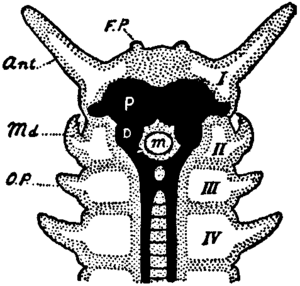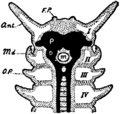Arthur Dendy facts for kids
Arthur Dendy (born January 20, 1865, died March 24, 1925) was an English zoologist. A zoologist is a scientist who studies animals. Arthur Dendy was famous for his work on sea sponges. He also studied land animals without backbones in Australia. One of his most famous discoveries was a "living fossil" called Peripatus.
Dendy taught zoology in different countries. He was a professor in New Zealand, then in South Africa. Later, he taught at King's College London in England. He was also a Fellow of the Royal Society, which is a very important science group.
Contents
Arthur Dendy's Family Life
Arthur Dendy was born in Manchester in 1865. His father, John Dendy, made silk fabrics. His mother was Sarah Beard. Arthur had sisters, including Mary Dendy and Helen Bosanquet.
In 1888, Arthur Dendy married Ada Margaret Courtauld. They had four children together. They had three daughters and one son. One of their daughters, Vera Ellen Poole, became an artist.
Arthur Dendy's Amazing Career
Arthur Dendy studied zoology at Owens College in Manchester. He earned his master's degree in 1887. Later, he received his doctorate degree in 1891.
Studying Sea Sponges
Dendy helped write a report about the Challenger expedition. This was a big science trip that explored the oceans from 1872 to 1876. He described a type of sponge called monaxonid sponges.
In 1888, Dendy moved to the University of Melbourne in Australia. There, he studied almost 2,000 sponge samples. These sponges came from the sea near Port Phillip Heads. He wrote ten science papers about Australian sponges. He even found and described 87 new types of sponges! Because of this work, Dendy became a top expert on sponges. He helped to reorganize how sponges are classified.

Discovering Australian Land Animals
Arthur Dendy was the first zoologist to study land animals without backbones in Victoria, Australia. He wrote 16 science papers about these animals. He also found 79 new species.
These new species included land flatworms and ribbon worms. But the most famous animal he studied was the "living fossil" Peripatus. This animal is special because it looks very similar to its ancient ancestors.
Teaching and New Ideas
In 1893, Dendy became a professor in New Zealand. He taught biology at Canterbury College, Christchurch. While in New Zealand, Dendy came up with a new term. He called animals that live in hidden places "cryptozoic fauna." These animals live in places like under rocks or in leaf litter.
Later, in 1903, he became a biology professor in South Africa. He taught at the University of Cape Town. In 1905, he moved back to London. He became a professor of zoology at King's College.
Honours and Special Recognitions
Arthur Dendy wrote articles for the 1911 Encyclopædia Britannica. He wrote about sponges for this famous encyclopedia.
He was also the president of the Quekett Microscopical Club. This club is for people who love using microscopes. He led the club from 1912 to 1916.
Scientists have named some animals in his honour.
- The worm Arthurdendyus was named after him. One type, Arthurdendyus triangulatus, is known as the New Zealand flatworm. It is an invasive species in the United Kingdom.
- The sponge Dendya was also named after him.
- Another sponge, Arturia, was also named to honour him.
See Also
Images for kids



